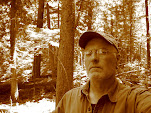Getting out in the canoe this winter has been difficult. We've had a few unusually long stretched of windy weather interspersed with good old fashioned cold that created enough ice to force a retreat to areas near the salt water. This morning comes calm with a steely gray sky, the advance warning of snow in the afternoon. The temperature when I set out is 27F, but the previous days have been warm enough that the only ice should be the thin overnight skim that forms in calm spots.
I put in at my usual start point about a mile upriver of the marsh. The tide has been coming in for about an hour, so the opposing flood current is still fairly light.
The mile down to the marsh has more Ducks and Geese than normal. This is a hunting pattern that I have begun to recognize; hunters anywhere in the marsh push much of the waterfowl to the outer edges, which are no hunting zones because they are near houses.
One of my current projects is to determine the rate of accretion (soil accumulation) in the marsh. So far, I've been collecting old bottles as the become visible in the cut banks. Bottles can often be dated to a five or ten year span without any scientific equipment, and at this point, I have a 50 years per foot estimate of accretion. (In the above photo, the soil at the water level would date to some time around the Civil War.) However, much of the marsh doesn't cooperate due to it being mudflats, or for some reason, just lacking debris where I need it. So, lately I have been looking into old maps and writings about the marsh. Generally, I want two independent sources before I "begin" to trust any story. One item that I read reported that the marsh was more of a bay during the 19th century. I have my doubts about that as the only old maps (ca 1830-40) from that era that I've located were made for the purpose of selling or taxing land. Those maps are drawn showing open water everywhere that there isn't solid land, and the lack of any marsh symbology, especially on the edges and backwaters shows that the mapmaker considered marsh to be non-land, which is not an unusual viewpoint for that time period - if you couldn't build on it, farm on it, or mine it, it was useless. Some of the "bay" idea might very well extend from viewing inaccurate maps. The first good map series that tried to show land as it was are the early USGS topographic maps, which were begun in the 1890's. There are some old sea charts, but then again, they don't bother much with marsh because you couldn't drive a steamboat through it.
I head down the main channel following the outside of Nell's Island, flushing one Harrier from the spartina as I go. My only side trip is to check out the main entrance to the center of the island. It is shallow with the low tide, but never having been in here at low tide, it's worth the look because one never knows until one goes. After a hundred yards, it goes too shallow to proceed.
I continue down, passing a hunters' boat tide off to shore. As I round the point to come back via Nell's Channel, I spot the Goose hunters about 200 yards in. I decide to leave them alone and turn back up the main channel.
At the top of the marsh, I head back a ways into Beaver Creek, flushing about a Hundred Canada Geese and several dozen Ducks. They fly off being careful to avoid flying over the main marsh where the hunters are. They're birds, they're not stupid.




No comments:
Post a Comment